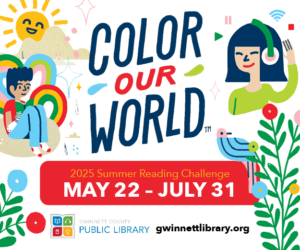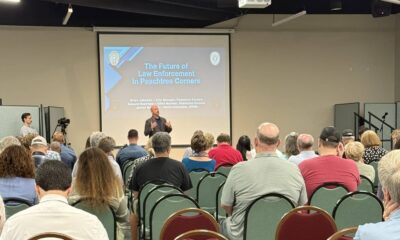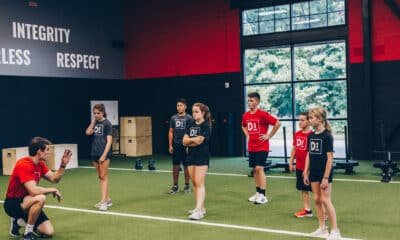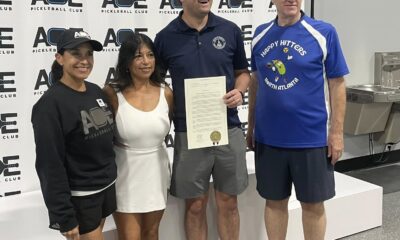Arts & Literature
How the Wesleyan Artist Market Converted to a Virtual Market for 2021
Published
4 years agoon

The Wesleyan Artist’s Market has been a celebration of local and national art and community creativity. With all of the changes of this past year, the volunteers and leaders of this event are innovating with how to continue to put on a great show in a virtual way. Join Karl Barham and Rico Figliolini on this very exciting episode of the Capitalist Sage as they sit down with the many wonderful organizers of this event.
Resources:
Website: https://artistmarket.wesleyanschool.org
Timestamp / Where to find it in the podcast:
[00:00:30] – Intro
[00:02:23] – About Kirsten, Nadine, Gina, and Megan
[00:06:13] – Transforming the Market to Virtual
[00:08:42] – The Live Market Experience
[00:10:46] – Choosing an Online Platform
[00:15:52] – Benefits of Online Art
[00:21:47] – Sharing Art Online
[00:25:40] – Artists Being Seen
[00:30:09] – Shipping Logistics
[00:32:29] – Importance of Getting Involved
[00:38:28] – Closing
“We always talked about how do we increase our foot traffic? For years, we kept trying to figure out, what are the logistics to figure out where people are coming from and how can we expand?And so now, one of the benefits hopefully is that we will supersede Georgia from patrons, ideally. Similar to how our artists come from all over the country.”
Podcast Transcript:
Karl: [00:00:30] Today we’re going to, on the Capitalist Sage podcast, we’re going to talk about
how a local artist’s market is going virtual in Peachtree Corners. Today’s guests we’re going to
have Kirsten Scott, volunteer coordinator at the Wesleyan Artist’s Market. Nadine Aram,
principal designer of NAK design and volunteer coordinator of the Wesleyan artist market. Gina
Solomon, volunteer coordinator with the Wesleyan artist’s market. And Megan Brooker artist
and art educator, and the assistant director of fine arts at Wesleyan school and faculty advisor to
the Wesleyan artist’s market. Welcome to the Capitalist Sage podcast. We’re here to bring you
advice and tips from seasoned pros and experts to help you improve your business and your
community in general. I’m Karl Barham with Transworld business advisors, and my co-host is
Rico Figliolini with Mighty Rockets, digital marketing, and the publisher of the Peachtree Corners
magazine. Rico, how are you doing today?
Rico: [00:01:28] It’s beautiful outside, I’m doing fine, thank you.
Karl: [00:01:31] It sure is. Spring is here for sure. Why don’t you introduce our sponsor before
we get started?
Rico: [00:01:38] Sure. We’re fortunate to have Hargray Fiber as a sponsor of these podcasts,
both Capitalist Sage, and the other podcasts that we do. Peachtree Corners Life and such. They
are a company here based in the Southeast, actually based in Georgia, that handles IT and
internet connectivity for companies throughout the Southeast. Small and large enterprise sized
businesses. Go check them out. They have products and information that you can use as a
small business or enterprise sized business that can make your internet connection faster and
better and provide the tools that you need to make your business work. So check them out at
Hargray.com/business and that’s our sponsor. Thank you, Hargray.
Karl: [00:02:23] We’re so glad to have Hargray as our sponsor, and a great business in the
community, helping us through all our technology needs for business and for residential in the
Peachtree Corners and greater Atlanta area. Today’s guests are going to help us understand
how the Wesleyan artist’s market has pivoted and made a shift over the past year to be able to
bring us a virtual experience of the auction. The dates of the Wesleyan artist’s market this year
is going to be April 22nd through the 29th. And please go online and check out their webpage,
all their social media to help spread the word about attending it in this new and exciting way. Our
guests today, Kirsten Scott, Nadine Aram, Gina Solomon, and Megan Brooker is going to talk to
us a little bit about their experience in pulling this together and how they helped the feature of
the artists and improve the experience in some way for people that are going to attend. Why
don’t I let them introduce themselves a little bit, starting with Kirsten, would you give a
introduction?
Kirsten: [00:03:30] Hey I’m Kirsten Scott. I am a resident here of Peachtree Corners and my two
children attend Wesleyan. I am a retired real estate attorney and turned homemaker with a side
gig flipping houses. And my real heart is for service which is a family character trait that was
passed along. And I’ve truly enjoyed being a part of the Wesleyan arts Alliance and the artists
market and many other service opportunities that are presented throughout the community, so.Karl: [00:04:05] Nadine?
Nadine: [00:04:07] Yes, I’m Nadine Aram. Also a resident of Peachtree Corners. We are very
lucky to have our two older children attend Wesleyan and in the past few years, we’ve been very
active with the artists market and the arts Alliance. By trade I’m an architect and designer. After
a couple of years in the corporate world, I started my own design firm doing more residential
work. So it’s been wonderful being able to work within the community. Harking a little bit how the
market functions too, a very open community event. So it’s been a wonderful experience and we
look forward to being able to talk about it today.
Karl: [00:04:42] Thank you. How about you, Gina?
Gina: [00:04:45] Hey, I am Gina Solomon, and I am a former resident of Peachtree Corners after
many years. And currently live in Berkeley Lake. I have a commercial banking and corporate
finance and treasury background. But like Kirsten and these other ladies are drawn to the
service side and have been a full-time volunteer for a couple of organizations over the years.
But I’ve spent a lot of time at Perimeter school and then Wesleyan school, the Wesleyan arts
Alliance. And then several other organizations as again, as a full-time volunteer. And this is my
ninth year associated with the Wesleyan artists market. It’s been an exciting and obviously very
interesting year.
Karl: [00:05:33] Fabulous. And Megan, why don’t you introduce yourself.
Megan: [00:05:37] Sure. I’m Megan Brooker. I teach high school art here at Wesleyan, and this
is my 14th year here, which is crazy. And I’m the assistant director of fine arts. So the lead for
visual arts, K-12 at this school. I’ve been involved with the artist’s market since my first year
here, which is, it’s been really awesome to see how much it has grown with leadership like these
ladies that are here with us, from the Arts Alliance. To see how much they pour into the school
and pour into the market is inspiring. So we’re very thankful for the Arts Alliance and the artists
market and all that it has to offer us.
Karl: [00:06:13] Well, after the past year, I know folks are so excited to get back to normal and
do things that, that we’ve done for many years. Gina, why don’t I start with you and just talk a
little bit about, some of the things that you’ve been able to do to help transform the live
experience of the artist’s market to virtual?
Gina: [00:06:34] Okay. Planning for the Wesleyan artist’s market is really almost an all year
around process. So when we finished the show at the end of April, we go into wrap up mode in
May, and then we start pre-planning over the summer. So it was this past summer where we
had to make the decision and work with the school on our plans for the 2020 show. And it
became fairly apparent that there were so many uncertainties associated with COVID that we
had a tough decision to make. Which was either go ahead and plan for a live show at the risk
that it might be canceled again, not have a show, or pivot to virtual. And because we feel likethis is the artist’s market is such an important tradition, not only for our school and our
immediate community, but our extended community and also for the artists. We made the
decision that we in fact would go virtual. It was unchartered territory for us, and there were
certainly, there has not been a roadmap. It was a big decision, but we felt like we had to put one
step in front of the other and go ahead and start making plans. So we announced that we were
going virtual in September and we were very fortunate early on to secure the support of many of
our longstanding partners and kind sponsors, such as the Peachtree Corners Magazine, the city
of Peachtree corners, Atlanta homes and lifestyle magazine, Imagine advertising and
publishing, Stirrup Media. These key partners, as well as Wesleyan school to help us deliver the
market going forward. So the first key thing for us was, the most important thing was to make
sure the artists were on board. And then secondly, to build a platform, an e-commerce platform
or secure any contract with an e-commerce platform to set this up virtually.
Karl: [00:08:42] If I could ask a question for those that may be new to Peachtree Corners, can
you quickly describe what the experience was like when it was live? And then we could talk a
little bit of what it’s going to be like when it’s virtual?
Gina: [00:08:54] Sure. The live event is an absolute highlight of our calendar year. It’s the
largest community building event at the school. The campus is open. Everybody is invited to
attend. Admission is free. We set up the show, the live show in Powell excuse me, in Powell and
Nancy gymnasium, which is a two floor expansive gym. And we have typically about a hundred
artists, professional and student artists combined on two floors over a three-day period. The
setup takes about internally, about a week for us to get it physically set up. The artists come in
wednesday before the show and then they pack up and leave Saturday night after the show. It’s
like having an enormous party for about four straight days. There’s a ton of energy. Nothing can
replace our live show. But ironically, over the years we have contemplated perhaps having a
virtual component to our live show. So while we did not choose this fate that ultimately we
ended up going fully virtual, this has given us the opportunity to pursue it and hopefully build
something that future generations of marketers at Wesleyan can use in a live show. When the
participating artists do set up booths at our live show, so you’ll see the individual booth set up
with all of their artwork displayed and the artists are actually present at the show which is
unique. Not all shows have the artists for the entire time, but we do feature all the artists.
Karl: [00:10:46] Oh fabulous. If I could ask Kirsten, when building out the experience in a virtual
world, can you talk about some of the things you had to consider and choices and platforms to
be able to do that?
Kirsten: [00:11:01] We did, we had to at the live market, we had entertainment and speakers
and we had to figure out how to bring some of that warmth to a virtual platform. And we did a lot
of research and we were guided with some other events that have happened that had a lot of
content. And they really advised us that we needed to be specific about our content and not
overdo it so as to distract the shoppers from the art. Which is really where we want everybody to
be engrossed is feeling like they get the opportunity to see the art that they typically would see
live and in person. And so we created some platforms and our presenting sponsor AH and Lmagazine provided us with a great opening night video where we’re going to cover the art of
collecting and excuse me. And that is a great conversation between art collectors and designers
and artists, where they can express a really great insight on how to go about collecting art
yourself personally. And that’s our opening night. We’ll also of course always have opening
remarks from Chris Cleveland head of school. And he’s always very excited and supportive of
our market. And I think he gets very excited about being able to kick it off and start it. We will
have that as well. A couple of other platform things that we’ll have will be a featured reel with
highlighting our Wesleyan fine arts program. In the past, we’ve had different variants of the
students be able to come in and the chorus be able to sing or the play members be able to
perform a small part of the upcoming play for the spring. And so this year will just be a highlight
reel focusing on those students and all their accomplishments they’ve been able to do this year.
And it’s a very unique environment. The teachers have been amazing, from a parent
perspective on really encouraging these kids to keep their artistic motivation going. And that’s,
we want to highlight that as well. And then we’ll have another little tidbit from one of our other
sponsors called Choo Choo Charcuterie. And she is, they’re going to perform or host a how to
put a charcuterie board together and some of the insight and the neat things that we’re all
seeing nowadays and supporting their local business. And finally, we’ll have a date night. Our
great sponsor Grace 17-20 is helping us create a unique menu for our Monet and Merlot date
night. And we’re hoping that guests will go and pick up a little something to eat and a little glass
of wine when they get home and enjoy shopping online with their spouse or their children. We
have the student artists as well, so we really want to encourage everybody to be thorough on
the site and take their time. We have a whole week to shop. It’s really great, yeah.
Rico: [00:14:01] Sounds exciting. So let me ask you, let me ask you this. When you, and I know
part of the process you ladies were going through at the very beginning, trying to find the right
platform and stuff. What was, what were like some of the key ingredients or features that you
liked about deciding where you are right now on the platform you’re using? And what are those
key features that someone else might be able to look at? It’s like, alright, that’s cool. I want to be
able to do the same thing. Even if it’s not an artist market could be something else. So if you
could share that with us.
Gina: [00:14:38] Okay. And y’all please jump in as well. There are some great, there are some
great e-commerce platforms out there. We ultimately did choose Shopify. And simply we did
want a very established name that there would have, there would be great recognition, not only
from the artist’s standpoint, but also from our buyers. And we liked the ability to customize the
program a little bit. It’s not as simple as simply setting up a store on your e-commerce platform.
Effectively we are the mall owner and we have the individuals store set up within our mall. So
it’s an extra layer and that has meant bringing in some different apps and working with a lot of
different people from different parts of the world to put this together, different time zones. And so
it’s definitely again, been an extremely interesting process. We did like the breadth and depth
and scale of Shopify and their ability to work with us to customize some things.
Karl: [00:15:52] What are the things that Shopify, for folks that don’t know it’s an online
e-commerce platform that a lot of people it’s one of the most known and well used. But whatcomes with that is trust. People know what that is and are comfortable and have used it, so
they’re familiar with it. But it changes the approach when you think about art and buying art. And
Nadine, I’d love to explore with you a little bit about how does someone like me who’s used to
going and looking at things, art to buy. How do I approach that virtually? How would you advise
shoppers and people participating in the Wesleyan event approach shopping for art this way?
Nadine: [00:16:36] Yeah, of course. Look, there’s no doubt that 2020 put a different spin on
things in life for everybody. Virtually everyone knows, everyone’s gone online to some capacity.
You even see big museums, like natural history museum, doing these virtual tours. Conventions
going to virtual booths. We’re coming in on that front as well and trying to the biggest impact
here. One of the biggest hallmark features of the Wesleyan artist’s market is the fact that it’s
always been a market for everybody. We’ve had all price points, all sizes of work, all types of
techniques, all types of skills. So that’s been a big factor for us to make sure that we drive
home. And I think when you approach trying to purchase artwork online you have to come to a
little bit, come to terms of you have to approach it a little bit more clearly. Because like Gina
said, nothing will replace an in-person experience. So you, so instead of being able to touch and
feel things you have to think through a little bit more logically. So typically, we always tell people
that when you come to the market, something will speak to you. You’ll find something that pulls
you in and just having an original piece of artwork at your home is really a special thing. And in
that vein, we always have a wide breadth of patrons, right? So we have people that come with
their own designers trying to fill in spaces for their homes or their offices, all the way to people
coming in to do personal shopping for themselves or little gifts for mother’s day, which is
typically about a month after the artist’s market. But there’s about four main tips I think, is a good
approach to when you try to purchase artwork online. And the first one is defining your intent,
right? So you come to the market with ideas in your mind. Is it for you? Is it a gift for someone?
Are you looking for some small filler pieces or a large piece to fill a large space? Knowing what
you’re wanting to come to the market with is important. The other aspect is understanding the
space, right? So again, is it a large piece? A small one? Bright colors, dark colors. Does your
space have high ceilings? Would it be more impactful for smaller pieces or the idea of a
triptych? So two to three pieces coming together. Horizontal, vertical, floral, landscape, abstract,
animals. We have the whole breadth of that, which has been a wonderful key feature of the
market. So we cover all types of genres, which is really a big benefit for people that come to our
store, to our market virtually, not store. The next one I would say is researching artists lists. So
visiting our website is a really big help that way, you know and can anticipate the artists that you
feel like you have a connection with. Whether it’s a technique, whether you like water color,
maybe you notice that you really do love oils. Maybe you do love a sort of whimsical piece that
artists put together. So being able to take a look at taking a look at our website and scoping out
our social media, because we’re doing daily, almost daily and weekly postings of all of our
artists. And we have a wonderful feature that’s called behind the scenes. And so you’ll have
artists speak about how they create the work. Images or videos of them creating the work. So
that’s another sort of draw to be able to replace that in-person experience. So that the patron
has a connection with the artist, which is also really important. And then the last one, I think,
which is really important too, is ask questions, right? When you find that artist or you find that
piece of artwork that you really do like, don’t be shy and reach out to the artist, email,sometimes they put a phone number. Giving them a call, maybe asking them for advice,
knowing your space and your height and your color scheme. No one would know better than the
artwork than the artists themselves. And then if there’s something that you’d like from a specific
artist, but it’s not the right color or it’s not the right size, our artists are typically always open for
commissions. Which is a wonderful piece too, because then you really have something
extremely unique for you and your space and asking questions and being descriptive is
wonderful. So it’s a different approach. But it’s definitely an approach where it’s happening
globally. Big name museums are doing it. The MOMA’s doing it. Like I said, natural history
museums are doing it.
Now we’re doing it here in Peachtree Corners.
Rico: [00:20:43] You know the good part. Also, like you said, you can communicate directly with
the artists as well. So if I was looking at a three dimensional piece, a sculpture or a plate, I could
probably ask them, can you shoot me a video? Walk around, then give me a 360 of what that
looks like in real life and show me scale.
Nadine: [00:21:00] Right, absolutely.
Gina: [00:21:03] And not to interrupt, but one other thing too, the capability of the site, the artists
will be submitting. Many of them will submit multiple images per piece of artwork. And they’ll
show you what it would look like hanging on a wall, or for example, sitting on a coffee table and
then you’ll have the ability to zoom in on the artwork. So you can see brush strokes, you can
see texture. It’s really, buying art online has become a standard. And we’re actually pretty
excited about the potential here. So we are seeing good things from pure shows and heard a
good thing. So our expectation is that it will be successful.
Karl: [00:21:47] One of the benefits that I’ve seen on these virtual art shows is the ability to
share with other people. That’s harder when it was in person. I walked in, I like it, but I have a
cousin in another city or somewhere else that’s not there. Virtually during your social media
posts, is it easy for people to share that with people in their network, friends and family? This
might be a good fit for them.
Nadine: [00:22:16] Yeah, absolutely. Especially on social media, it’s an easy thing to do where
you can repost or you can resend it to message to someone, Facebook and Instagram, for sure.
But even the week of the market, being able to just copy and paste that link directly to an artist I
think is even more impactful. We always talked about how do we increase our foot traffic? For
years, we kept trying to figure out what are the logistics to figure out where people are coming
from and how can we expand? And so now, one of the benefits hopefully is that we will
supersede Georgia from patrons, ideally. Similar to how our artists come from all over the
country.
Rico: [00:22:52] Now, we did a podcast recently with the Atlanta Jewish film festival. They did
everything virtual film festival. Whereas before they were stuck just in the Metro area and within
a few theaters. Now they were opened up almost to the world. Although I got to say that someof the videos, some of the films can only be geo located and screened. So Georgia limited too
or let’s say US. But they were able to expand the amount of people participating, not only the
films, I think showing, but also the participation of people showing up to watch those films. So is
that the same feeling you’re getting when you went out for artists, are you finding there are
more? You’re open to a wider range of artists because it’s virtual versus them having to show up
and set up?
Gina: [00:23:36] Absolutely.
Rico: [00:23:38] That is the best part of that? Isn’t it?
Gina: [00:23:41] Well it’s been, again, it’s been really exciting. We have artists coming from New
Orleans, we have Colorado. We have places where normally they would not be traveling this far
from. We do have obviously still a strong mix from the Southeast. But we can tell from the
people that are following us on social media and the groves on those accounts. As well as the
applicants for the show that this was, it was a broader net basically.
Rico: [00:24:11] And it’ll probably be great to see the actual statistics during the Showtime to
see where your visitors are coming from. And where the purchases are actually coming from.
That would be nominal to see that part of it, as a business person looking at this, right?
Kirsten: [00:24:25] I think one of the added benefits of going virtual is that, and one of the
reasons that I think that we would like to keep this component part of the market is because of
the reach we have been able to attract and jury artists and have them be part of the show that
they normally would not be able to do because of either distance or time constraints with a live
show. And so the virtual really allows us to have a broader reach. And like you said, we’re real
excited about seeing those statistics come in, so.
Nadine: [00:25:01] Yeah, I will just add onto that, in the past the way we’ve tried to help artists
that can’t be in our market in person is we’ve always tried to do a curated section. But now I feel
with this, we all collectively feel with this sort of virtual market that now the whole market is even
more curated. You really did vet the process of getting and achieving high quality artists with
wonderful work, great ethics, as best as a price point as we can. That’s the biggest benefit
right? To doing it. It is literally a one-stop shop for all types of artwork. And jewelry. Don’t forget
jewelry.
Karl: [00:25:40] I’d be curious on getting an artist perspective, Megan. This new world and
getting from an artist perspective, how do you see that changing how artists can get their work
seen? And are there any tips and advice you’d have on people using this new platform to
feature their art?
Megan: [00:26:02] Yeah, it is. It’s actually really exciting to see how the potential of what is going
to actually happen, moving from live to virtual. Because the beauty of the live show is the
interaction you have with the client. And Nadine mentioned the intent, like I feel that from theartist perspective, when the intentions match and what you’re looking for match. In that, what
the artist poured into it is what the client is looking for. It’s easy to communicate when you’re
live, right? When you are in person. And when somebody stands in front of your booth, this is
my favorite part of the artist’s market. Besides the big party, as Gina mentioned. Is that, is they
stand in front of your artwork and when they have an emotional reaction, it’s a beautiful thing.
So I will miss that live, but I’m hoping that and my goal as an artist of the market is to be able to
portray that and to explain that and make sure my intention comes across virtually. So whether
that be through captions or in marketing, and making sure that. Because I feel like this is a huge
piece of reaching your clientele that your work is created for. And so I think it’s interesting too. It
is a different, it’s almost employing a different level of marketing as an artist. Because as
several of you mentioned getting different angles of the artwork to make sure that everybody
can understand what it looks like on the wall, but also details of what it looks like close up and
what it might look like in different scenarios. Could you couple it with other artwork or what does
it look like on your shelf? So having the different variety to approach the, as much as the live
scenarios you can get virtually is super important. Sharing your intention and making sure your
purpose of your artwork is known. Because some may come in just wanting something that
matches their decor, but then there’s many others who want something that they do interact
emotionally with. But I do find that no matter which way, what we’re looking for as a client,
people want to know our story. And so I’m thankful for the platform like Shopify and all the art
clients is doing to help us to create that story on this web page so that it is shown through social
media and through our individual pages.
Karl: [00:28:21] I know in the past year, I don’t know if you’ve all had the same feeling because
of us having to isolate more. I’m seeing more expression of people’s feelings and passions
online. They’re reacting to things. If it’s an image, if it’s a story you’re seeing that. And I think
more people have become comfortable using that medium to communicate that. That’s one of
the things I’m excited about is in this forum, most times you don’t get to interact with the artists
in many cases. But I could see the opportunity through what you’ve created in this virtual
experience, the ability to have before interactions with the artists and the art and respond during
the artist’s market experience and potentially after. We’ve mentioned commissioned work, or I
follow your work now and get an exposure for those artists, that’s harder to do in just a purely
in-person event. After you leave the event, you may not see or can’t stay connected as easily.
So I think the time has come for this merging of the two and you’re able to leap frog into that.
Probably we were all forced to. But I think your idea of keeping elements of that as we bring
back the live experience next year, my fingers are crossed, next year live and in virtual. Are
there things that I want to ask a practical question of, when someone comes and makes a
purchase, there’s actually the buying part. And then there is the, how do I get the art, whether
it’s three-dimensional art and so on. Can you speak a little bit about how would that happen
during the event this year?
Gina: [00:30:06] Sure. Kirsten. Do you want to take that or?
Kirsten: [00:30:09] Sure. Yes. So the plan right now, because it’s all virtual is that we would,
each of the artists are setting up their own shipping portion of the market. And so with that, theywill be responsible for making sure that the art is packaged correctly. And with everything going
virtual or online for the past year, they have gotten a lot of experience on how to properly
package art and have it shipped out correctly. There is the option that with just our professional
artists, that again, communicating that if you’re local and there’s an opportunity to do a local
drop-off or a handoff. That is a relationship and a contact that you, that the artist and the patron
can foster and make happen so that the shipping costs aren’t added on for something that’s
local. And we’re hoping that maybe we’ll get an opportunity to actually host the artist on campus,
but that’s just, that’s Wesleyan’s decision. And we honor that decision and it’s would be, it’s up in
the air right now. As far as hopefully doing a on-site handoff opportunity where patrons could
come and meet some of the artists and actually pick up their pieces on campus. It would be
great to be able to bring folks back on campus. But like I said, Wesleyan is in charge of that and
they have done an amazing job of keeping our students on campus. And that’s their priority and
we honor that. So yeah.
Karl: [00:31:41] Would you want to add anything on that?
Gina: [00:31:43] As far as the delivery is concerned, when we were at, we were advised by a lot
of the consultants on this, that when we have a hundred different points of where the items are
going to be shipped from. And so whoever can, whoever controls the inventory really needs to
manage that process. And that’s the artists. We don’t have or control the inventory. So they,
once the sale is completed, then the individual artists will reach out to their buyers and they will
obviously secure whether the item is going to get mailed or whether it’s going to get picked up at
the artist’s studio or whether there’s going to be a meeting place. They will make sure that the
art is delivered one way or the other.
Karl: [00:32:29] I’ve got a question, if I could throw out to each one of you to respond to. If there
was one thing you wanted people that are planning on attending or people that have attended in
the past or especially people that have never attended. If there was one thing you’d want them
to know about the Wesleyan artist’s market that should drive them to want to attend or
participate or how they can get involved. What would that be? Nadine you mind if I start with
you?
Nadine: [00:32:54] Sure.
Karl: [00:32:57] Take your time. I know that it was a big question.
Nadine: [00:33:00] Yeah. There’s a lot of there’s a lot of thoughts going through my head, I think
right off the top. I’ll just say, I think participating in any capacity as a patron with the artist’s
market is a wonderful benefit to our students. And I don’t just say our students in the time that
they’re here K through 12, right? Because there are a lot of extremely talented children, really
they’re young adults by the time they graduate. But that will go out into this world and will do
some fabulous things. And I think they are able to do so because they’re catapulted by our
wonderful fine arts program of which the Wesleyan artist’s market is the biggest, it is their
biggest benefactor. So I think ultimately it does come full circle, right? Because we do havesome alums that are coming back and participating as artists in this market. And so the bigger
feedback loop is the fact that yes, you are gaining a wonderful and unique piece of artwork.
Students who have a huge love of fine arts continue on and have all the facilities that they can
have so that they can do the best performance that they can do, be it 2D or acting or music. And
I think that’s the biggest driver for us. And it’s been every year, to be honest with you has been
okay, how do we increase our bottom line? How do we increase our profit? Because at the end
of the day, it’s not going to our pockets, it’s going to help our children and the other students.
And I think that’s the, for me, that’s what drives me to keep going and what I hope other people
and patrons would consider.
Karl: [00:34:37] Fabulous. Megan, what do you think would be something that folks should think
about in supporting this in ways they can?
Megan: [00:34:46] Yeah, I actually was. I echo everything Nadine just said. That was the same
sentiments I was thinking. And I would add to that, that you can buy art anywhere, pretty much
any store. You can go to any local store and find something to hang on your wall to match your
couch. But this offers the unique opportunity to give back and to create a story that goes full
circle with the school, that is helping local artists, that is supporting local. But more than that it’s
creating so much hope in life. And just, I guess I’ll just say a story again, that is so much more
meaningful. That you could see every day, or use every day with jewelry, that’s so much more
impactful to your daily life.
Kirsten?
Kirsten: [00:35:30] Gosh, ladies y’all have done an amazing job of covering it. It truly is. It is the
story. I love that Megan. Where I look around at the pieces that I’ve purchased over the years
and every time I see them, there’s a story. There’s something behind it. There’s an experience.
And I know that like Nadine said and Megan said, that experience goes further than just myself
and my joy that I get from the art itself. But it passes on to all these children that go through and
experience, the amazing program of fine arts at Wesleyan. And we just want to continue to
support that and grow that aspect because it is critical for education and for expression. And
we’ve seen, like you said earlier, a great deal of people expressing themselves in ways that we
just never thought we would ever see. And we’re all getting to share it. I love the part of the
community about the fine arts. It is a community event and we’re expanding our community by
being virtual. And I love that. Because expanding your community as you can go years without
seeing somebody and then you’ll come across somebody in 10 years and go, gosh I remember
when I met you at the Wesleyan artist market or something to that effect. And so that’s exciting.
And the last component would be supporting our artists. With losing last year’s market we really
had a very big heart in making sure that we could do anything we could to help support the local
artists. And now our reach has gotten further and we know the importance and the value of the
artist. And so we wanted to continue to make sure that happened.
Karl: [00:37:17] Gina, would you add anything to what everyone has said?Gina: [00:37:22] The main thing I would say is the artist’s market for me, has always been so
much more than an event. It’s truly an experience. And I’m so impacted by not only the art, but
by the artists themselves. And in a really, it’s been a tough year for a lot of people on a lot of
different fronts. And this is as much about inspiration and offering some hope and a little bit of
escape. And also just it’s, I always find it so educational. So there are so many different
benefits beyond just, finding that particular piece. It’s really just the whole experience and it’s
and all are invited. Again, it’s our favorite part of this event is that we do get to open up the
doors and hopefully share the great art, beyond the Wesleyan campus. We’d just love for, to
continue to hopefully inspire through this event.
Karl: [00:38:28] Well, I know Rico probably feels the same as I do, and I want to thank you each.
Gina, Nadine, Kirsten, Megan. Not only for being a guest today and talking about the Wesleyan
art market, but for your time in volunteering and pulling this together. It’s been a tough year and
figuring out a way to bring this to the community here in Peachtree corners and beyond. I want
to thank you personally for all you’re doing. And for all the artists that are participating and for all
the people that people don’t see behind the scenes, I know there’s IT folks and technology folks
and logistics folks that help make this happen. And I really want to see the community come out
and support this more than ever. If you can’t get there those days, you could do it on your couch
at home and explore some of the art during that. So thank you for your service and for all that
you’re doing for the community and for Wesleyan and for artists in general.
Gina: [00:39:27] Our pleasure. And let me add, we did extend the show from three days to a full
week. So that hopefully allows everybody a great window to take a look and join the site.
Karl: [00:39:41] So can you remind me of the dates and how can people learn more?
Gina: [00:39:46] The dates are April 22nd through 29th. If you’re a sponsor, there is a preview
starting April 20th through the 22nd and it’s not too late to sponsor. So go to our website at
ArtistsMarket.WesleyanSchool.org. You can also check us out on social media, on Instagram,
Facebook, and Twitter. And those accounts are listed on our website.
Karl: [00:40:13] Thank you very much for your time today and for sharing all the hard work
you’ve done and I’m excited to go. I got to visit it when it was live. I’m excited to go visit it now
that it’s virtual and next year I’ll even be excited to doing a little bit of both. So thank you for all
that you’re doing.
Kirsten: [00:40:33] Thank you.
Karl: [00:40:35] I’m Karl Barham with Transworld business advisors. And Rico and I have
enjoyed getting to learn more of the many organizations, businesses, schools in the community,
and putting on the Capitalist Sage to bring you just what people are doing to innovate and to
help other people get ideas of how they can keep going and overcome challenges. Whether it’s
in their business or in their organizations that they support. For me our business advisors at
Transworld Business Advisors, we help consult business owners. We help them figure out howto get into business when they’re ready, how to get out of business and sell when they’re ready
and how to grow their business in between. And I can be reached at
www.TWorld.com/AtlantaPeachtree. And Rico, why don’t you tell us a little bit about what you
have going on and how people can reach you if they’d like to.
Rico: [00:41:26] Sure. So I publish Peachtree Corners Magazine as a lot of people know.
Started that out two years ago and we’re working on our next issue. So if you’re interested in the
artist’s market, one of the big features we have is we’re highlighting three of the artists in that
issue. That’ll be coming out the beginning of April. We’re also highlighting four student artists. In
fact, we’re doing another podcast later today. We’re recording with two student artists that’ll be
on Peachtree Corners Life. So that’s cool. It’s getting to know a lot of what’s going on and being
able to put that word out for Wesleyan artist market. Magazine has, is going to be the biggest
issue yet. I think we’re going to be 80 pages this issue. We’re going to be covering a lot of
different things. If you’re into tennis, USTA, recovering that we’re covering the new multi-use
ordinances the city has passed. That’s going to deal with development over the next decade in
this city and what that means with regard to multi-use when it comes to apartments, condos,
retail, office space. Things are changing. COVID has done all that to us. So we’re evolving.
Traffic has changed. The way people are living has changed. So the city has to contend with
that and that’s what they’re doing. So we’re, hopefully we can explain some of that. There’s a
bunch of other things in there. I also own Mighty Rockets. I do digital marketing, content
creation, and handle social media for several different companies. So if you’re looking to get
involved or you need to expand your presence online. Whether it’s product videos or content,
just reach out to me. You can go to MightyRockets.com or you could check my name on
LinkedIn. There aren’t too many Figliolinis out there. So you’ll be able to find me if you put
Atlanta. But this has been fun. I love talking about this. I’ve been involved with you ladies for, I
don’t know how many months now it’s been going back. Six, seven months maybe? Longer
actually. Yeah, actually before Nadine’s…
Nadine: [00:43:21] So it’s been almost two years.
Rico: [00:43:22] Yes. It’s been good to see this whole process evolve and to see how it’s
developed from the beginning. So I’m just excited. I can’t wait to participate.
Gina: [00:43:33] Thank you again.
Karl: [00:43:36] Thank you. And also, I just want to recognize Megan, thank you and for all the
teachers out there that have been helping take care of our children. So we really do honor you
and thank you and bless you for all that you and other teachers are doing. So thank you for that.
Megan: [00:43:51] Art therapy is a real thing, so.
Karl: [00:43:52] It is. Thank you for joining the Capitalist Sage Podcast today. Look forward for
future episodes. We’ll continue to bring you advice from leaders in the business and in thecommunity and talk about how they could improve that and help improve the community in
general. Have a great day, everyone
Related
Arts & Literature
Experience Shakespeare in the Park with Contemporary Classics’ Twelfth Night
Published
1 month agoon
April 11, 2025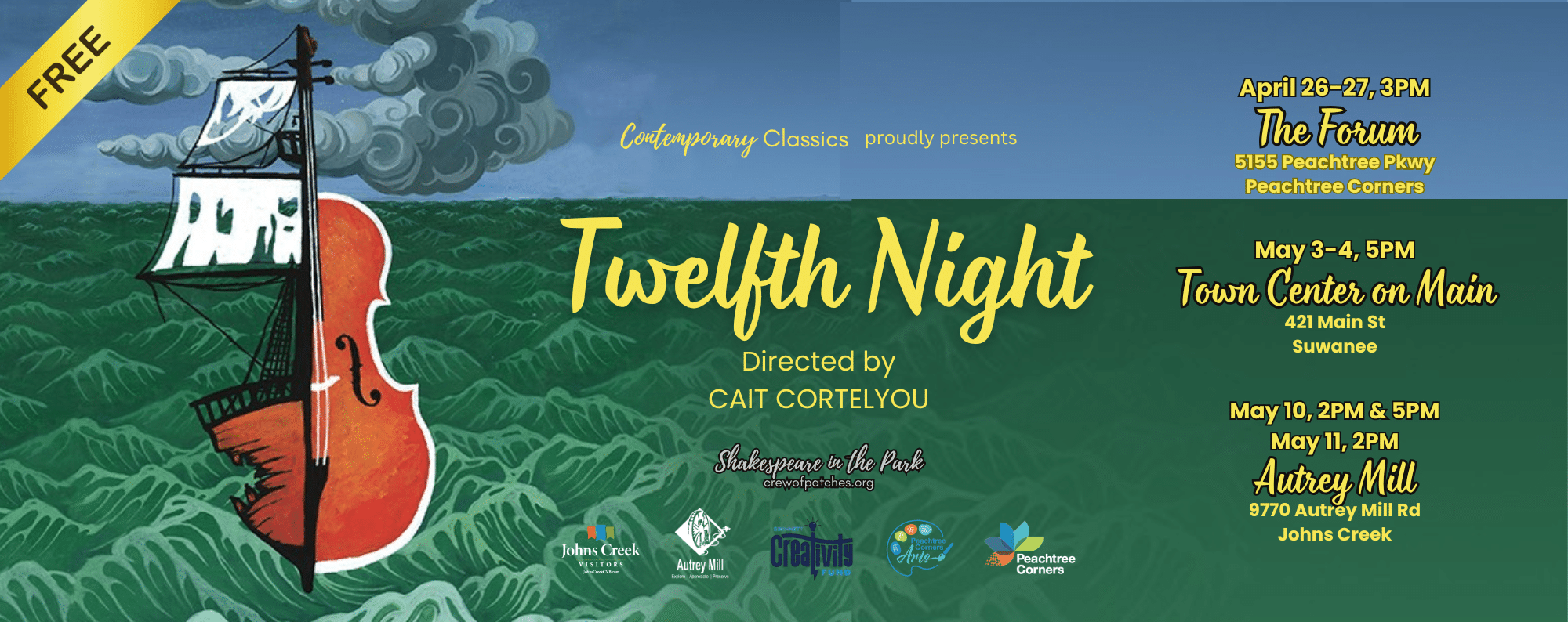
Contemporary Classics Theatre will present Twelfth Night, a free “Shakespeare in the Park” experience at three beautiful outdoor venues in north metro Atlanta
Twelfth Night, William Shakespeare’s romantic comedy of mistaken identity, will play at three beautiful outdoor venues in north metro Atlanta from April 26 to May 11.
Directed by Cait Cortelyou, known for her award-winning feature film “Ask for Jane,” Twelfth Night is a rollicking ensemble comedy explores unrequited love, misperceptions and the instability of gender.
Set in the coastal town of Illyria, young Viola survives a shipwreck and finds herself alone, believing that her twin brother died at sea. Disguising herself as a man, she finds work with the Duke Orsino, quickly falling in love with him. Orsino, however, is in love with the Countess Olivia… and Olivia quickly falls for Viola.
Meanwhile, Olivia’s steward Malvolia has bullied the household for the last time — and the staff is out for vengeance.
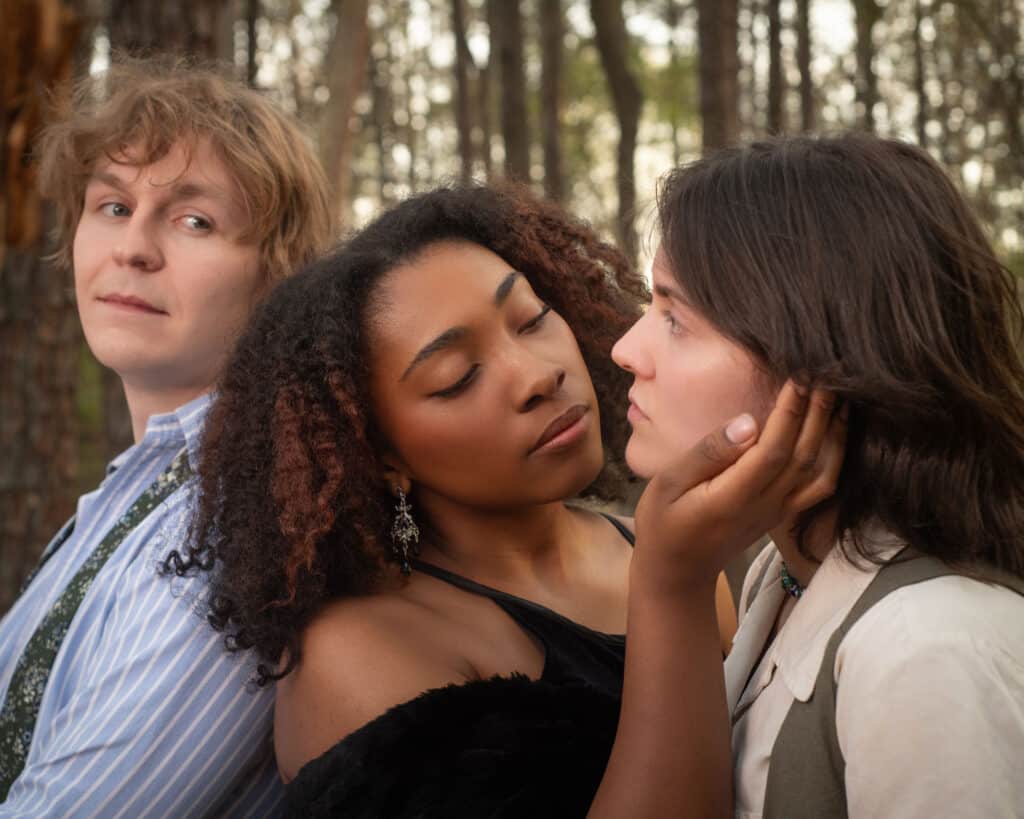
This timeless production of Twelfth Night features Allen Cox, Carl Fisk, Ryan Hutchins, Shem Louis, Susanna Lyne, Steven Medina, Matt Metzger, Danielle Montgomery, Macros Nora, TJ Sanson and Elliott Posadni as one of the first transgender actors to play Viola.
It also features costumes by artist Jordan Hermitt and production design by Sage Kim Gray.
Locations, dates and showtimes
The Plaza at The Forum Peachtree Corners • April 26–27 at 3 p.m.
Audience seating and a special musical performance will start at 2:30 p.m. Please note that seating is limited; arrive early and/or bring lawn chairs or blankets. Food and drink are available for purchase at the venue.
Town Center on Main, Suwanee • May 3– 4 at 5 p.m.
Audience seating and a special musical performance will start at 4:30 p.m. Please note that no seating is provided; bring lawn chairs and blankets. Coolers are welcome (no alcohol). Food trucks will be onsite at the venue.
Autrey Mill Nature Center, Johns Creek • May 10 at 2pm & 5 p.m.; May 11 at 2 p.m.
Audience seating and a special musical performance will start at 1:30 p.m. on both days and at 4:30 p.m. for the evening show on May 10. Limited bench seating only. In case of inclement weather, the show will move from the amphitheatre to the open-air Pole Barn nearby.
Admission to the shows is FREE. Register online for tickets.
About Contemporary Classics
Contemporary Classics exists to challenge and transform classic Western theater traditions by creating an inclusive community of diverse people, ideas and cultures. They believe that classic work is made even greater when performed by a larger variety of artists — especially those who have been marginalized by Wester theatre traditions — including women and people of color.
With no permanent home, the theatre company partners with places such as public parks for performance spaces. This “homeless” state is one of the reasons they call ourselves “a crew of patches”— they travel from “patch” to “patch” with their shows.
The name also comes from a line in A Midsummer Night’s Dream, and reflects the “motley” coat of a Shakespearean clown (or fool), created by sewing patches of old or discarded clothing together in a mishmash of textures and colors, like a patchwork quilt.
Fools, or “Patches,” transcend societal norms by being simultaneously a part of society and outside of it, giving them the ability to examine and comment on it.
For more information, visit crewofpatches.org.
Related
Arts & Literature
From Food Creations to Handmade Jewelry: Wesleyan Kids Prep for Artist Market 2025 [Podcast]
Published
1 month agoon
April 7, 2025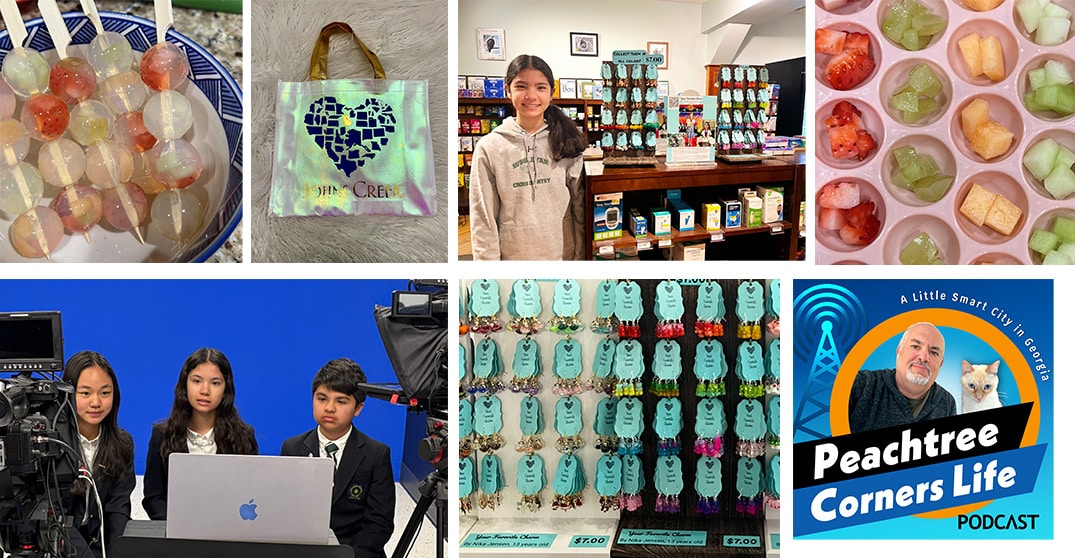
In this episode of Peachtree Corners Life, host Rico Figliolini spotlights three remarkable student artists featured in this year’s Wesleyan Artist Market. Eighth graders Kimberly Wang and Nika Jensen, along with sixth grader Carter Jensen, share their creative journeys—ranging from edible art like fruit jellies and peppermint bark to handmade jewelry and custom-designed bags.
Kimberly talks about her love for food art and balancing sweetness with fruity freshness, while Nika and Carter discuss building a jewelry business that also gives back—donating proceeds to families in the Philippines. This isn’t just an artist market; it’s a showcase of purpose-driven, globally inspired young talent. The event runs April 25–26 at Wesleyan School and is open to the public.
Podcast Takeaways:
- Kimberly Wang creates handmade edible treats, balancing flavor and freshness for the show.
- Nika and Carter Jensen co-run a jewelry and fashion accessory business, inspired by global travel and cultural experiences.
- Nika donates part of her proceeds to support families in the Philippines.
- All three students are deeply involved in extracurriculars—from musicals, marching band, math club, and academic bowl.
- The Wesleyan Artist Market features 24 student artists and over 70 professionals—open to the public April 25–26.









Timestamp:
00:02:19 – Student intros and extracurriculars
00:03:06 – First-time participants and motivations for joining
00:04:13 – Kimberly’s edible art and recipe testing process
00:05:16 – Nika and Carter’s jewelry and bag design business
00:07:06 – The reward of watching people enjoy your creations
00:08:20 – Donating art profits to support families in the Philippines
00:10:39 – Future aspirations in medicine and law, with art as a passion
00:12:06 – Behind-the-scenes logistics of preparing for the market
00:13:25 – Global travel inspiration: 73 countries and counting
00:17:19 – Where the students draw artistic inspiration
00:20:04 – Custom requests: From peppermint bark to Lego earrings
00:21:16 – Anticipation and excitement for this year’s market
00:22:29 – Reflections on Wesleyan and the artist experience
Transcript:
00:00:01 – Rico Figliolini
Hey, everyone. This is Rico Figliolini, host of Peachtree Corners Life. We have a great set of guests today. Because of the upcoming Wesleyan Artist Market, we thought we’d do some interviews with student artists. Three of the 24 that are going to be at Wesleyan Artist Market. So they’re with me here today. So we’re going to get right into that shortly. I just want to say thank you to our corporate sponsors. So I want to say thank you to EV Remodeling, Inc., based here in Peachtree Corners. The owner is Eli. Him and his family live here. They’re great. They do a lot of design work, design your space. Essentially, any home remodeling you need from whether it’s your kitchen, your bathroom, or a whole house remodel, or even an addition to your home, think about it, whatever you need, Eli can handle. So check them out. Go to evremodelinginc.com and find out how they can design your space and your life. Our next sponsor just came on, and they’re Vox Pop Uli. I want to thank them for joining us as well. They deal with all sorts of things you can imagine putting your logo on, similar to a little bit about what these kids do, right? They’re creating artwork. They’re creating a brand for themselves. And so this is what Vox Pop Uli does, right? They’ll take your brand and bring it to life. Essentially, anything that you can think of that would go on apparel, whether it’s sweaters or T-shirts or wherever you want to put your brand engraving, your logo, what object you want to put it on, even vehicle wraps. So if you’ve got a truck, you want to put a whole wrap around it, check them out because they can do that. They’re here in Peachtree Corners and they’re called Vox Pop Uli. So visit their website. I’ll have the links in the show notes as well. So thank you guys. I appreciate your support. So now let’s get right into it. Let me introduce our three artists, great Wesleyan students. Can’t wait to start talking to them. We have Kimberly Wang first on your left, on my left, and Nika and her brother Carter Jensen, who work together creating the artwork they do. So I’m going to ask you guys just to, you know, give me a little background. Tell me who you are, your grade, what you do, extracurricular, stuff like that. This way our audience can get to know a little bit more about you. So let’s start with Kimberly Wang. Hey, Kimberly.
00:02:19 – Kimberly Wang
My name is Kimberly Wang. I’m in eighth grade this year, and outside of Artist Market, I do marching band, and I also do the musical production this year, which is Matilda.
00:02:31 – Rico Figliolini
Excellent. What about Nika? How about you?
00:02:34 – Nika Jensen
I’m also in eighth grade. My name is Nika Jensen, and apart from doing the Artist Market, I do cross country. I’m also in Matilda this year, and I also do math counts, which is a math club.
00:02:47 – Rico Figliolini
Okay, cool. And Carter?
00:02:49 – Carter Jensen
Hello, my name is Carter Jensen. I’m in the sixth grade. And outside of the artist market, I do academic pool and I also do basketball.
00:03:00 – Rico Figliolini
Excellent. Alright, cool. So have you guys ever done the artist market before? Is this the first time?
00:03:06 – Kimberly Wang
This is my second year doing it this year.
00:03:08 – Rico Figliolini
Second?
00:03:10 – Nika Jensen
Yeah, this is our first year because we’re new students this year.
00:03:13 – Rico Figliolini
Alright, cool. What inspired you to get into it, Nika?
00:03:17 – Kimberly Wang
Well, I had my own business before we came to Wesleyan and so I thought that the artist market is a good way to like show my business to other people in our community. So yeah.
00:03:30 – Rico Figliolini
And you brought in your brother Carter to help you with?
00:03:35 – Nika Jensen
Yes, sir. He’s also part of the business.
00:03:39 – Rico Figliolini
Alright cool. Okay so, Kimberly. Food. Food is art, right? I’m sure your mom would probably say, it’s food, just eat it. But you’re playing with your food, essentially. What they used to tell you not to do, right? So when you create your food art, what do you think about? How do you go through this? How do you choose what you do and what do you exactly do?
00:04:13 – Kimberly Wang
So this year, I am making fruit jellies and peppermint bark. And when I think about what creations I want to make for the artist market, I go online and I look through like, what are some popular desserts that a lot of people like? And once I like choose my items, then I go through
the recipe and then I do a lot of trial and errors to make sure that like the products are like healthy and they taste well.
00:04:42 – Rico Figliolini
So they have to be edible, right? Because this is edible art?
00:04:45 – Kimberly Wang
Definitely, yes.
00:04:46 – Rico Figliolini
So are you eating a lot of the edible art before you get to what you need?
00:04:50 – Kimberly Wang
Not really. I don’t usually taste a lot of the food. I let my family taste it.
00:04:56 – Rico Figliolini
Ah, good. I like that. Yes. Get them to participate. Cool. So edible art, that’s one way of doing it. Jewelry, that’s something else, right? Wearable. How do you guys, Nika, Carter, how do you get to the place of what you do?
00:05:16 – Nika Jensen
So I started my business when I was 11 years old and it started like I got my first jewelry making kit and I kind of just expanded from there. So like I usually use Amazon to search and find like the prettiest designs like of earrings and pendants and get opinions from other people like my mom and my family to see like if they think it’s like wearable and if they like it. So I browse on Amazon for a while and I find like the best and high quality products and then I hand make them at home usually like every day after I come home from school so and my brother he does something else and he can tell you about that.
00:06:01 – Carter Jensen
I, my sister, she got a Cricut machine for, like, her 12th birthday, I think. And started making these, like, iron-on bags with the Cricut machine and, like, making them based on, like, Georgia and, like, Wesleyan and designing it based on fashion.
00:06:19 – Rico Figliolini
Alright. Cool. So let’s get back to Kimberly. The food that you do. Do you have particular flavors you like? Do you have particular areas that you stay in?
00:06:33 – Kimberly Wang
So this year I’m trying out like something more sweet with chocolate. But last year I definitely went for more of like the fruity side. And I think I like to keep it like a balance. So that way one is not overpowering the other. My personal favorite will probably be fruit because it’s healthy. And I mean, it just tastes good in general.
00:06:56 – Rico Figliolini
Okay. Alright cool. What’s the most rewarding part that you can think of, of making edible art?
00:07:06 – Kimberly Wang
Well, I mean definitely like you said before you get to eat a lot of food. I mean, I did say before that I don’t eat a lot of the creations I make, but sometimes I still do eat it. And so I think it’s also really rewarding to see like people try out your creations and see like their reactions to what they think of it.
00:07:27 – Rico Figliolini
So when, I know I’ve spoken to other artists when they sell their artwork like paintings or stuff like that they get a chance to see it sometimes when the fan that bought it if you will, would send them a picture of where they hung it right? Yours disappears right?
00:07:45 – Kimberly Wang
Yeah, exactly.
00:07:47 – Rico Figliolini
Yeah I guess, there’s no way to, short of doing a selfie with it or taking pictures of it, there’s no there’s no permanency to it so how does that feel?
00:07:57 – Kimberly Wang
I mean well as long as the people enjoy it that’s good. And I mean I think mainly it’s about like the memory that you have of having the food and if you like it then it stays as a good memory for you and if you don’t then I mean you can always try out different things.
00:08:20 – Rico Figliolini
Okay. Nika, Carter, as far as the jewelry goes the, you’ve used it to raise money to support children in the philippines? yes
00:08:29 – Nika Jensen
Yes sir.
00:08:31 – Rico Figliolini
Is that, is that how you started this when you were 11? Is that the reason?
00:08:35 – Kimberly Wang
No, so I was like 11 during the pandemic. So I was always looking for a way to express my creativity. And so that’s how I started my own business. And so I was selling at my uncle’s pharmacy and I was saving up the money to use for like college or for like other events later on in my life. But this last year and a half before this school year, we were living in the Philippines. And so I was really touched by all of the families there. And we even did something similar where we gave out food and canned goods over Christmas to poor families there. So that just
really touched me. And so ever since we got back to America, I’ve been donating part of my profits to other families in the Philippines.
00:09:24 – Rico Figliolini
Carter, did you end up going on that trip as well?
00:09:28 – Carter Jensen
Yeah, I was with her. We stayed there for about a year and a half. We also did schooling there.
00:09:36 – Rico Figliolini
It’s interesting brothers and sisters, I have three kids and you know growing up brothers and sisters always there could be dynamics there. So how do you get along? Do you ever say to your sister, I don’t know about that. You know that might not look as good, that might not sell. Do you give good feedback? I mean how do you praise her or how do you work together?
00:09:58 – Carter Jensen
She’s more of the leader of the business so like I usually just like try to like agree with her and like yeah.
00:10:12 – Rico Figliolini
Alright that’s cool well you need a leader of the pack sometimes right? So Nika the artwork that you do, you know this is part of what you do you’ve mentioned other things you do right? I know you’re young, you all are, you know you’re not old enough to really think well maybe you are to really think what you want to do with your life right? Is art something that you want to keep as part of what you’re doing in your life?
00:10:39 – Nika Jensen
It’s definitely something that’s of great value to me, but I kind of want to pursue the medical field, but art is also really important to me.
00:10:49 – Rico Figliolini
Okay. Sounds good. Same question to Kimberly. What about you? How do you feel about the work you do?
00:10:57 – Kimberly Wang
I definitely enjoy making food, but like Nika said, I was also really interested in the medical field. And so like I’m not really sure if I’m going to continue pursuing this. But I mean it’s definitely brought me a lot of joy while doing food art.
00:11:15 – Rico Figliolini
Okay. Medical field both of you, that’s cool. What about Carter? How about you? 00:11:19 – Carter Jensen
I kind of like, I like doing art it’s one way to like express your creativity as my sister said. But I also kind of, I’m not really sure what I want to do when I grow up, maybe be a lawyer.
00:11:33 – Rico Figliolini
Okay. Well, artwork gives you a chance, right, to play a little bit, to be able to also see how people, like Kimberly, like you said about how when people see your food or taste your food and your food art, if you will, and it gives you a chance to see how people appreciate what you’re doing, I think, right? The challenges of making food art and keeping it fresh and making sure you’re going to deliver it on the right way I guess at the Wesleyan artist market, how do you how do you handle that part of it?
00:12:06 – Kimberly Wang
So for me the night before each day of the selling I would stay up really late and I make all my products so they’re all fresh and they’re all new. Because I want the best for the people that are eating the food because I don’t want anything to go bad overnight and so I make sure that it’s always new products and I make it, yeah.
00:12:32 – Rico Figliolini
We don’t have the same issue with the jewelry that you do, Nika. So that could last forever, right? But putting it together, sourcing the supplies, right, of what you do, the logistics of it, I guess. How do you handle that? Like getting all the materials together? Do you order it all on Amazon?
00:12:52 – Nika Jensen
Yeah, I order like 99% of all of my things from Amazon. And then since I already have the materials shipped to me, then all I have to do is just create them from my house. So it’s easier for me than having to go out and buy supplies at stores.
00:13:11 – Rico Figliolini
Sounds good. What inspires you as far as jewelry goes? I know that you said you look online to see other things and what the trend is. So where do you find most of your trends? Is it just on Amazon or is it social media, other places?
00:13:25 – Nika Jensen
I kind of observe other people and like what they wear and also social media. And I get a lot of inspiration also from like nature and from like my travels. We’ve been to a lot of countries in the past five years, 173 countries.
00:13:44 – Rico Figliolini
How many?
00:13:45 – Nika Jensen
I’m sorry, not 173, 73 countries.
00:13:49 – Rico Figliolini
73 countries?
00:13:50 – Nika Jensen
Yes, sir.
00:13:51 – Rico Figliolini
That you’ve been to in how many years? I can’t even wrap my head around that. How did you even do that? Teleport? I mean, how did you do that? Wow. What is your heritage, if you don’t mind me asking?
00:14:12 – Nika Jensen
I’m half Filipino. My brother and I are half Filipino. And then my father is part Danish and then also American.
00:14:21 – Rico Figliolini
Do you speak any languages?
00:14:23 – Nika Jensen
I speak the language of the Philippines called Tagalog and then English. And I’m learning Spanish.
00:14:30 – Rico Figliolini
Really? Okay. Kimberly, how about you?
00:14:33 – Kimberly Wang
So my mom is Taiwanese and my dad is Chinese. So I speak Chinese, English. I’m learning French and I’m learning Korean.
00:14:43 – Rico Figliolini
Really? Wow. Okay. Speak Mandarin, is it? Okay. My son was learning that for a year and he was, it’s a tough language to learn. But I’m sure being able to travel for example Nika, to be able to see other other countries and inspiration from those countries. What of the 73, 75 countries you visited what would you say the top five would be for that type of inspiration? Can you pick that up?
00:15:16 – Nika Jensen
I think so. I really like Argentina just because it’s so unique and the culture is just so strong there. Like you really feel so immersed just when you like step into the country. I like Italy, not only because of the food, but that’s also where I got a lot of inspiration for my jewelry. Just like the glass in Venice, like the Murano glass, like that’s also a really big inspiration. In Turkey, that’s when I first like found my interest in jewelry because there was, we went to this bead store and there was like thousands of different beads and I got to like choose different charms and like experiment with creating jewelry. So Turkey, Argentina, Italy, and then I have to give it to the
Philippines, obviously, because we lived there for so long. And then that’s hard. What do you think, Carter?
00:16:12 – Carter Jensen
I like India because I really like butter chicken. Also like Italy because I like pizza and pasta.
00:16:27 – Rico Figliolini
Yes, can’t get any better pizza than Italy, that’s for sure.
00:16:30 – Carter Jensen
Yeah, it’s really good there. And I also like Japan because it’s very futuristic and it’s like…
00:16:38 – Rico Figliolini
Is it?
00:16:39 – Carter Jensen
Yeah, it’s like a new environment and it’s like…
00:16:45 – Rico Figliolini
Yeah, cool. I can’t wait I think where, I think we may be heading there in July so that would be fun. I’ve never been so that would be interesting. Cool so with the artwork, with the inspiration, with the journey that you guys have been on, do you think that, are there any artists it’s hard and food maybe unless it’s Gordon Ramsay or something, but do you draw any inspiration? Who do you draw inspiration from for the work for what you do? Let’s start with Kimberly.
00:17:19 – Kimberly Wang
I don’t really have a specific artist that I look up to but I do watch some cooking shows and some like dessert making shows and they always really inspire me so I feel like that’s what really led me into like starting food art. And so I was like, whoa, this is really cool. And so I was like, okay, let me try this. And so now I’m here and then I’m like, this is pretty fun.
00:17:49 – Rico Figliolini
Oh, okay. Carter, I know you’re not the main person doing the artwork, but what do you see when you’re working with your sister? How does that feel working with her, doing the stuff with her, the artwork? Whatever you’re doing with her, how you know what’s that journey feel like for a brother and his sister?
00:18:13 – Carter Jensen
It’s kind of relaxing doing artwork and like peeling off like the stickers on the bags
00:18:26 – Rico Figliolini
Okay, alright, that’s cool. Sister, how do you feel?
00:18:30 – Nika Jensen
Yeah I just enjoy anytime I’m like I get to make jewelry because I feel like it’s such like an important thing to me. And it also like my brother said it’s really relaxing and just like sitting in our home and just like making jewelry it’s like, it’s really fun for me.
00:18:48 – Rico Figliolini
Do you wear? I’m assuming you wear some of the stuff you make?
00:18:51 – Nika Jensen
No actually I don’t have my ears pierced. And so I just like making it and seeing my creations on other people.
00:19:00 – Rico Figliolini
Okay, cool. Kimberly, do you ever decide, I’ve got to make something, I want to eat something, do you ever decide to do that, or is it always just for the art?
00:19:10 – Kimberly Wang
I think mainly just for the art. Because, I mean, I do piano outside of school, and so most of my time is sucked into that. But, I mean, sometimes if I do want to make something, yeah, I’ll go for it. And I’ll try my best, but it might not be successful.
00:19:31 – Rico Figliolini
Have you ever been, have you ever designed anything custom design? Because someone requested it from you? Like has anyone ever asked Kimberly, has any anyone ever asked yeah can you make that for me? Like aside from the artwork you sell.
00:19:50 – Kimberly Wang
I don’t think so. I did get one request by a high schooler to make peppermint bark for him for his art and science class. But like other than that, no.
00:20:00 – Rico Figliolini
Okay. How about Nika? Have you ever had a request for jewelry?
00:20:04 – Nika Jensen
Yes, I have. So my mom was posting some of my creations on social media and someone reached out to me and she wanted lego earrings like so little like lego figurines as earrings. So I used some of my own legos and then we also bought some but I drilled a hole on top of their head and I had to stick a screw inside. I had to mail it to them. And then they sent me a picture of them wearing it.
00:20:42 – Rico Figliolini
It’s just the way you were describing it, drilling the hole in the head. It’s like, all right, well, that’s good. So there’s the art. You do anything for art, I guess. That’s good. Great. We’ve been showcasing and talking a lot about art here and food and stuff. What are you looking forward to this year’s Wesleyan Artist Market? What is it that’s looking forward? I mean, you have there’s
three of you out of 24 other students. Have you seen or talked to other students and what they’re doing for the show, for the market? What are you looking forward to?
00:21:16 – Nika Jensen
To me?
00:21:17 – Rico Figliolini
Yeah, sure. Let’s go with it.
00:21:18 – Nika Jensen
Okay. Yes. Kimberly and I are actually really good friends so we’ve been like talking with our other friends that are doing the artist market and we’re like you know what they’re selling and yeah. I’m just really excited because we’ve never my brother and I have never done something like this before so I think it’ll be a really good opportunity and it’ll be fun so.
00:21:39 – Rico Figliolini
Something wholly new. That’s good, a good experience. How about you Kimberly?
00:21:45 – Kimberly Wang
Ever since last year, I was really astonished by everything I saw, even if it was like the adult artists, but like the student artists, they were all so talented. I know like a few other people are making food art and people like Nika are making jewelry. And so I’m honestly really inspired and just really blown away by all the effort that everyone puts in.
00:22:13 – Rico Figliolini
Cool. Anything that I’ve not touched on, guys, that you want to share about, individually about what it takes to do what you’re doing or your experience at Wesleyan? Why don’t we start with Kimberly?
00:22:29 – Kimberly Wang
I don’t really have much. I feel like this was a really nice opportunity to be able to share what Wesleyan Artist Market is about and how students have been able to participate in it.
00:22:42 – Rico Figliolini
Cool. Nika?
00:22:43 – Nika Jensen
Yeah so my mom printed out pictures of our time in the philippines so this first one it’s all the bags of food that my old school donated to families in the philippines.
00:23:01 – Rico Figliolini
Excellent. Glad you printed those out.
00:23:03 – Nika Jensen
This is my old class. This was this year when I sent my profits back to the Philippines. And those are all the boxes of food and clothes that they get with that money.
00:23:16 – Rico Figliolini
Wow, you really did make a lot of money.
00:23:18 – Nika Jensen
Yes, sir.
00:23:19 – Rico Figliolini
That’s good. That’s great. And maybe at some point I’ll ask Camille on this, getting some pictures from you all of some of the artwork that you’ve done. I’d love to include that when we post the podcast as well. And if you have any social media where you post your artwork on, if it’s public, feel free. We’re going to be sharing this and we’ll be taking you all as well. I think we got everything covered. I mean, you’re all just unbelievable kids. You’re just doing great work. And I’m just like, it’s always great to talk to you, to Wesleyan students, just like, or to students that are motivated, put it that way, to do things. So glad to see that you’re doing all sorts of things and I still can’t wrap my head around 75 countries, I’m just still trying to think that just like in five years, I can’t even see doing that. But I want to thank you all for for joining me so this is Wesleyan Artist Market you all will be at and that’s April Friday the 25th from 10:00 – 7:00 pm and Saturday April 26 from 10:00 to 3:00 pm. We’ve been talking with Kimberly Wang, who does food art, edible food art, and Nika and her brother Carter Jensen, who do jewelry. Appreciate you guys being with me and being so talkative and just being good guests. So thank you all. Hang in there with me for a second. Everyone else, I want to say thank you again for joining us. You can find out more about Wesleyan Artist Market from just going to wesleyanschool.org or just Googling Wesleyan Artist Market it’ll pop up for you. And it’s open to the public, Friday and Saturday in April. So check them out. Visit the 24 students that are displaying their artwork as well, along with the over, I think it’s over 70 professional artists there. And thank you all from, I guess you’re in Wesleyan Wolf TV station too. So appreciate you doing that with me. So thank you everyone. Stay well.
Related
Arts & Literature
Perimeter Ballet Celebrates 30 Years of Dance and Inspiration
Published
2 months agoon
March 14, 2025
Perimeter Ballet celebrates its 30th anniversary this year. Founded in September 1995, the faith-based ballet school in Johns Creek has long been an integral part of the local arts scene and the community.
What began as a bare-bones program held in the sanctuary of Perimeter Church — on carpeted concrete floors, using the backs of chairs for barres — has grown into a respected school of more than 200 students. Ranging in age from five to 18, the young dancers at Perimeter Ballet are not only committed to the study of dance but also to using their gifts to share their faith.
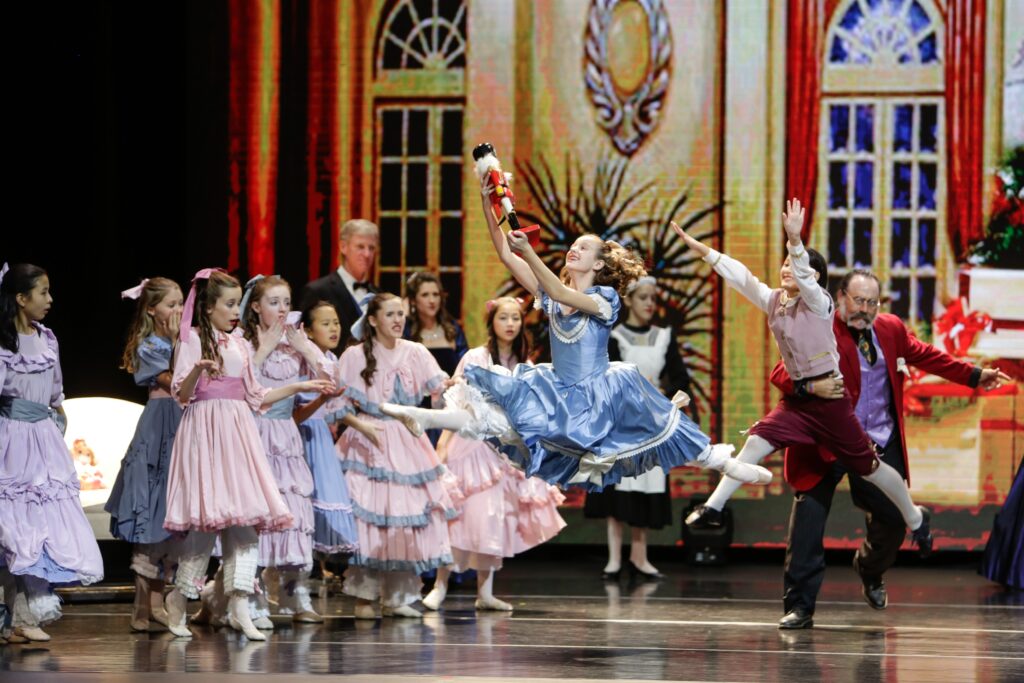
According to the program’s website, their purpose is to “emphasize character along with technique … to counter the natural tendency towards self-absorption in the ballet studio.”
They are “very committed to teaching children to dance — to develop discipline, technique and musicality. [But] the Christian instructors [also] train the students in a context that understands that there’s a reason to dance.”
30 years of dance and faith
Current director, Becky Brown, has led the school for several years, growing the program while faithfully following Perimeter Ballet’s original mission. She oversees weekly classes, summer dance camps and annual productions, including an acclaimed Spring Recital and a presentation of The Nutcracker each December.
For the 30th anniversary, Brown is excited to continue the creative work of the ballet school and share their artistry and message with a larger audience.
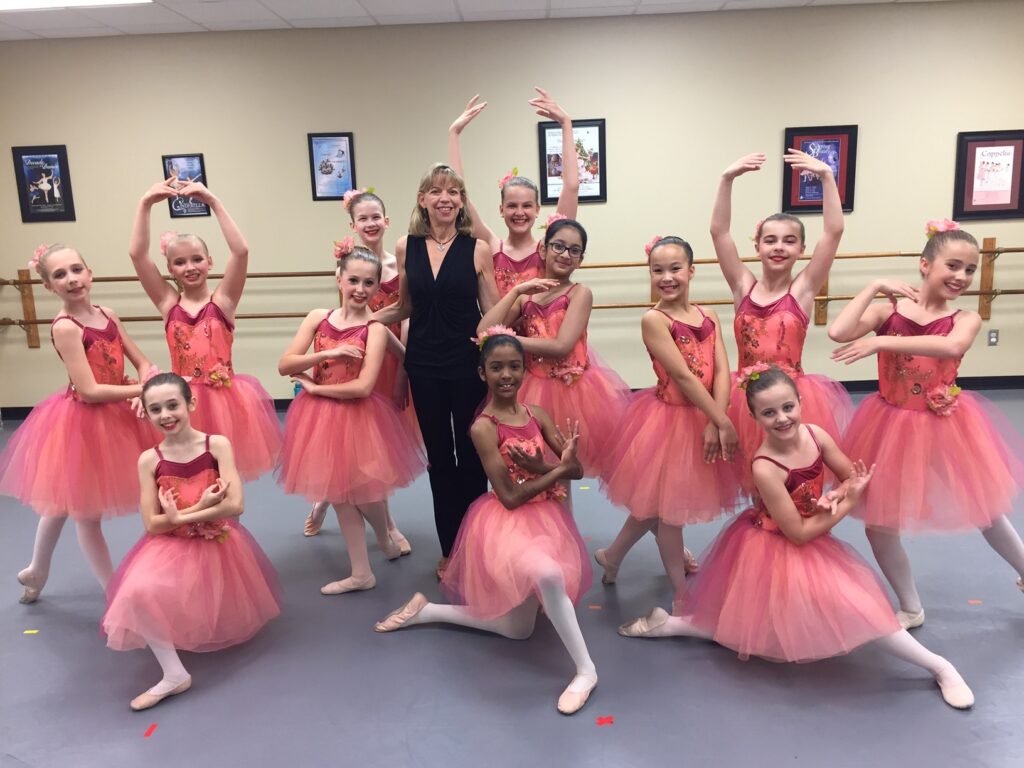
“This year will certainly be a special time for us as we celebrate and look back on 30 wonderful years of Perimeter Ballet and 20 years for our performing company, For His Glory,” she said. “We will be performing the Nutcracker December 11–13 and will have some beautiful new costumes to commemorate the occasion. We look forward to seeing many of our alumni and their families at the performance.”
Classes and instructors
Open to the community at large, weekly classes at Perimeter Ballet range from Creative Movement, PreBallet and grade-level classes for preschoolers through third grade to more advanced classes (two or more times per week) for older students.
Summer camp sessions as well as intermediate level and advanced level intensives are also offered. For the upper-level intensives, students work on their ballet technique but also branch out into jazz and other forms of dance.
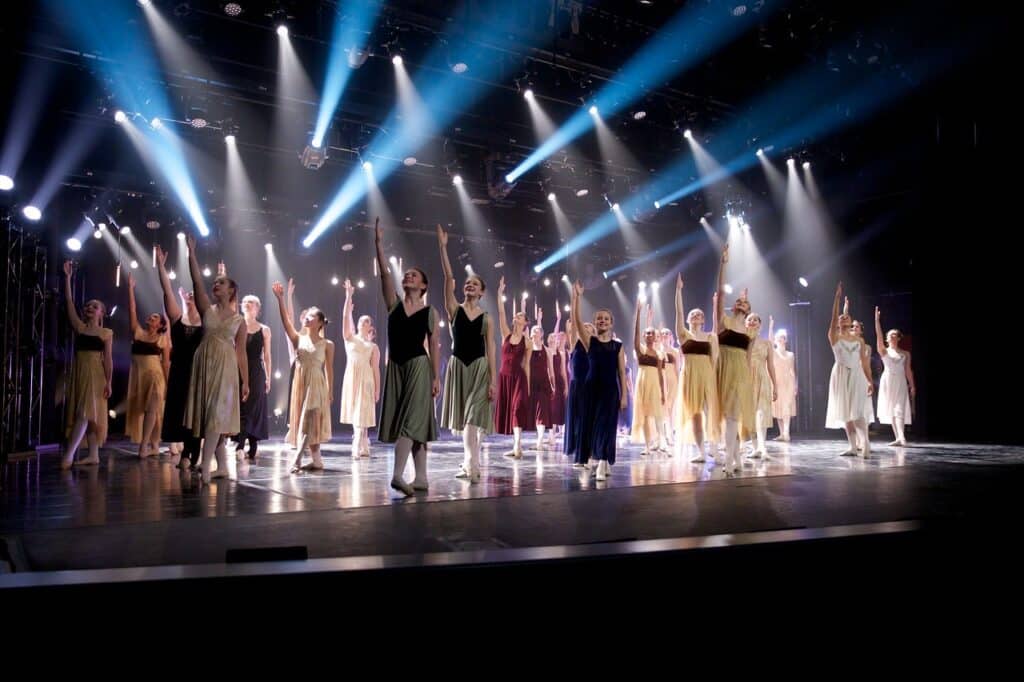
The school’s nine teachers are skilled not just as instructors but as performers themselves, having years of experience dancing with companies such as Ballet Southeast, Atlanta Ballet, North Atlanta Dance Academy and the Metropolitan Opera Ballet. They bring that experience and their Christian faith to all of their classes and interactions with the young students.
For His Glory
In addition to the work they do as a ballet school, Perimeter Ballet also has an audition-selected performance company — For His Glory.
With three levels, made up of dedicated students striving to advance their skills and reach their “God-given potential while giving glory to [their] Lord and Savior, Jesus Christ,” the program presents several high-quality productions throughout the year.
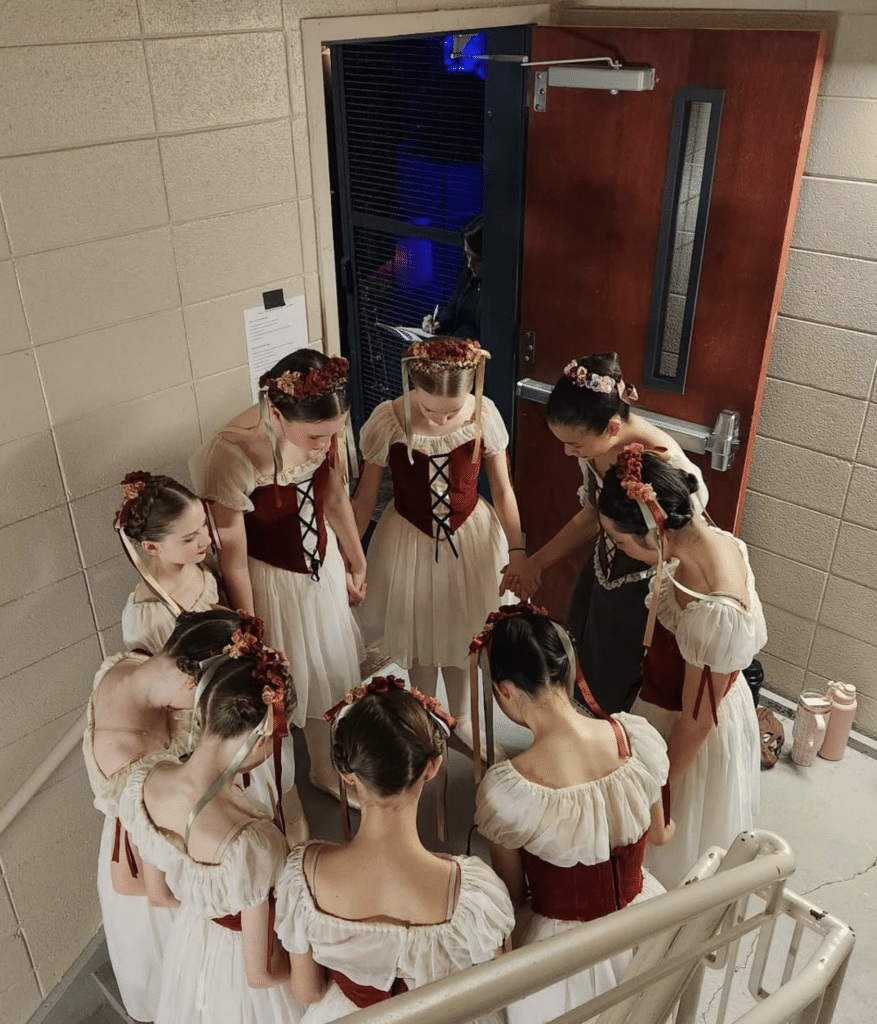
As Perimeter Ballet shares on their website: “Dancers are trained in the ballet classics as well as contemporary forms of dance, which are used in performances, worship settings and outreach. Classical ballets … in the group’s repertoire include Cinderella, Sleeping Beauty, Coppélia, excerpts from Four Seasons and La Fille Mal Gardee. In addition to Christmas and other outreach programs, For His Glory has danced internationally in London, India and Belarus.”
The group most recently performed Beauty & the Beast for two successful shows on stage at the Perimeter Church Sanctuary in early February of this year.
Impact and inspiration
All of this — the focus on faith and commitment to dance, the classes, intensives and stunning productions — have been a decades-long inspiration to the community and especially the student dancers who take part.
Many of the students stay with Perimeter Ballet for much of their childhood, learning and growing in dance as well as in their faith from elementary age through high school. That kind of involvement can clearly impact every aspect of their lives, from discipline learned to how they choose to interact with and be in the world.
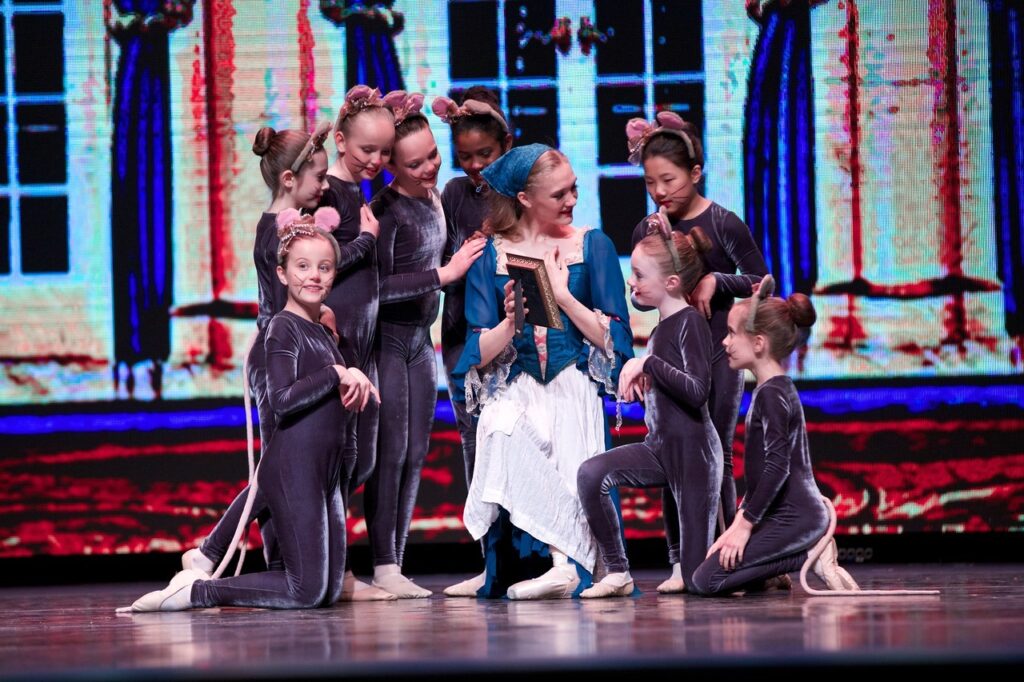
One student, Anne Bradley Maxwell has been taking ballet with the Perimeter program since she was three years old. Now a high school junior in Peachtree Corners, she’s reflected on her time at the school and in the performance company as well as Perimeter Ballet’s milestone anniversary.
“For fifteen years … I matured within this unique, local community arts program,” she shared. “This year marks the 30th anniversary of its founding … and I’m honored to say I’ve been a student for half of that era. The talented instructors in [the] program not only helped advance me into an accomplished ballerina but also into a more faithful servant of Jesus Christ using dance as a form of worship.”
A lifelong journey
“This lifelong journey included annual seasonal training, auditions, numerous external summer intensives and wonderful performances on stages across the nation and abroad, for audiences ranging from a few dozen to several thousand,” Maxwell continued.
“… Taking ballet has instilled in me a deep understanding of perseverance and resilience. Pursuing excellence in ballet required me to overcome physical and emotional challenges … I learned to seek out solutions — whether physical therapy for healing my body or prayer and reflection to rejuvenate my spirit. These experiences have strengthened my ability to face setbacks, adapt and emerge stronger.
Ballet has cultivated in me a unique combination of athleticism, discipline and creative imagination. The most elegant performances emerge from the interplay of technical mastery and creative expression. The collaborative nature of ballet, where individuals work in harmony to create something greater than themselves, informs my approach to teamwork and innovation, both in the classroom and community.”
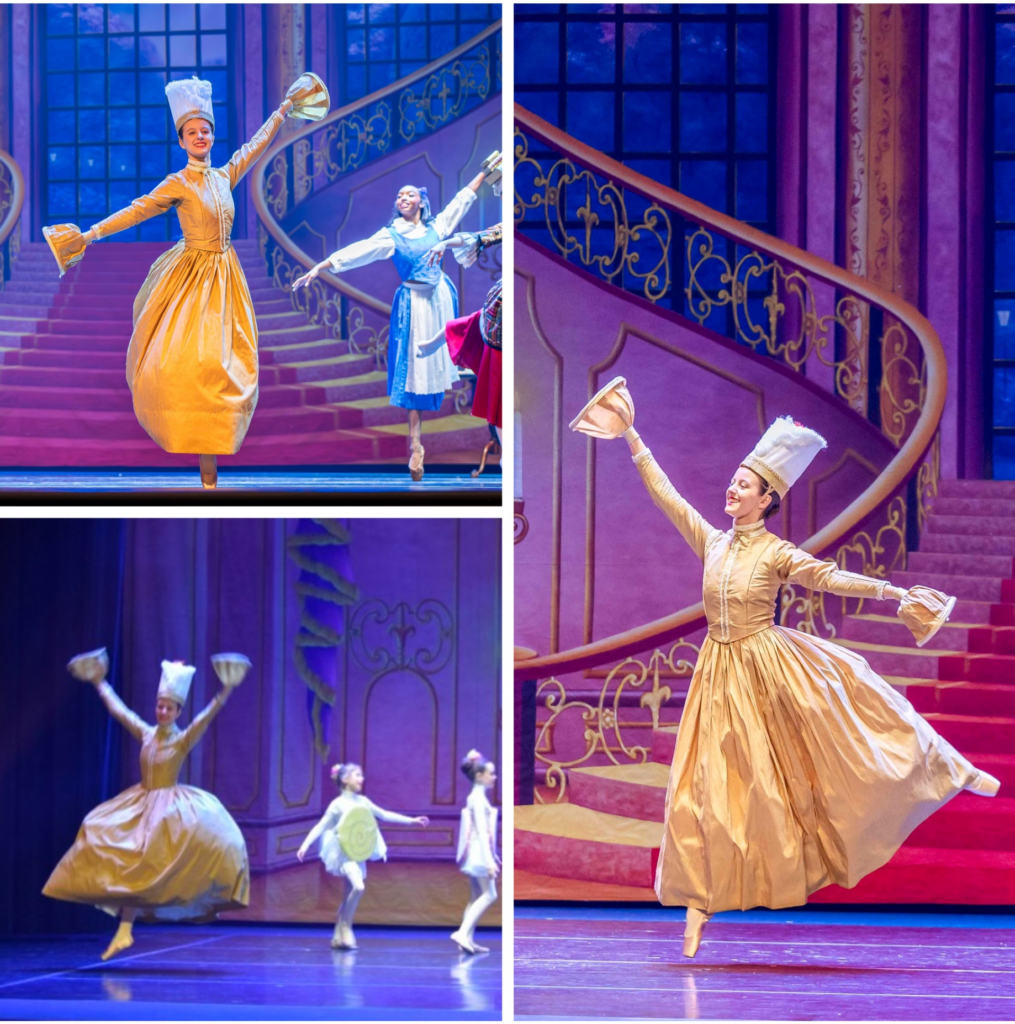
“… Ballet has [also] given me the gift of joy — both in experiencing it personally as a testament to Christ’s goodness and in sharing it with audiences. This joy, while intangible, is a powerful force that I hope to bring into my next chapters following high school. Whether through teaching movement, choreographing performances or exploring ways to expand ballet offerings, I aspire to enrich the community with the beauty and joy of dance.
… My time at Perimeter Ballet has equipped me with perseverance, discipline, creativity and a passion for sharing joy — qualities that I am excited to further cultivate as a young adult. These will not only enhance my personal journey but also contribute meaningfully to the rich tapestry of life. As I enter my senior year later this fall, I am full of gratitude for the solid foundation of technique and creative expression honoring God as the giver of my talent.”
Upcoming events
Perimeter Ballet’s Annual Spring Recital will be held in the Perimeter Church Sanctuary on Thursday, May 1 and Friday, May 2 from 7 p.m. to 8:15 p.m.
Summer camp sessions are scheduled for June and July. Registration will open on April 15.
2025-2026 classes will start in August with registration opening on April 15.
With help from Anne Bradley, the school is also planning a fundraiser event later in the year to mark the 30th anniversary.
For more information, visit perimeterballet.com.
Related
Read the Digital Edition
Subscribe
Keep Up With Peachtree Corners News
Join our mailing list to receive the latest news and updates from our team.
You have Successfully Subscribed!

Digital Edition

Official City Merchandise Line Debuts This Saturday at Town Green

Paul Duke STEM High School Student Earns CGO Scholarship

World Blood Donor Day Starts Here: Theo’s Miracle, Katherine’s Mission [Podcast]

Executive Function: A Tribute to Working Moms

Peachtree Corners Grows Business Opportunities Through Economic Development

Peachtree Corners Hosts Discussion About the Future of Local Policing

Simpson Elementary Marks Exceptional Children’s Week

Local Special Olympics Pickleball Team Honored with State House Resolution

Atlanta’s Dog Howl-O-Ween Festival Moving to Peachtree Corners for 2025

D1 Training Brings New Fitness Concept to Peachtree Corners

Peachtree Corners Hosts Discussion About the Future of Local Policing

City of Peachtree Corners Awarded Certificate of Achievement From GFOA for Seventh Straight Year

Simpson Elementary Marks Exceptional Children’s Week

Executive Function: A Tribute to Working Moms

Official City Merchandise Line Debuts This Saturday at Town Green

Light up the Corners [Video]

Capitalist Sage: Business Leadership in Your Community [Podcast]

Cliff Bramble: A Culinary Adventure through Italy

Top 10 Brunch Places in Gwinnett County

A Hunger for Hospitality

THE CORNERS EPISODE 3 – BLAXICAN PART 1

Top 10 Indoor Things To Do This Winter

The ED Hour: What it takes to Remove Barriers from Education
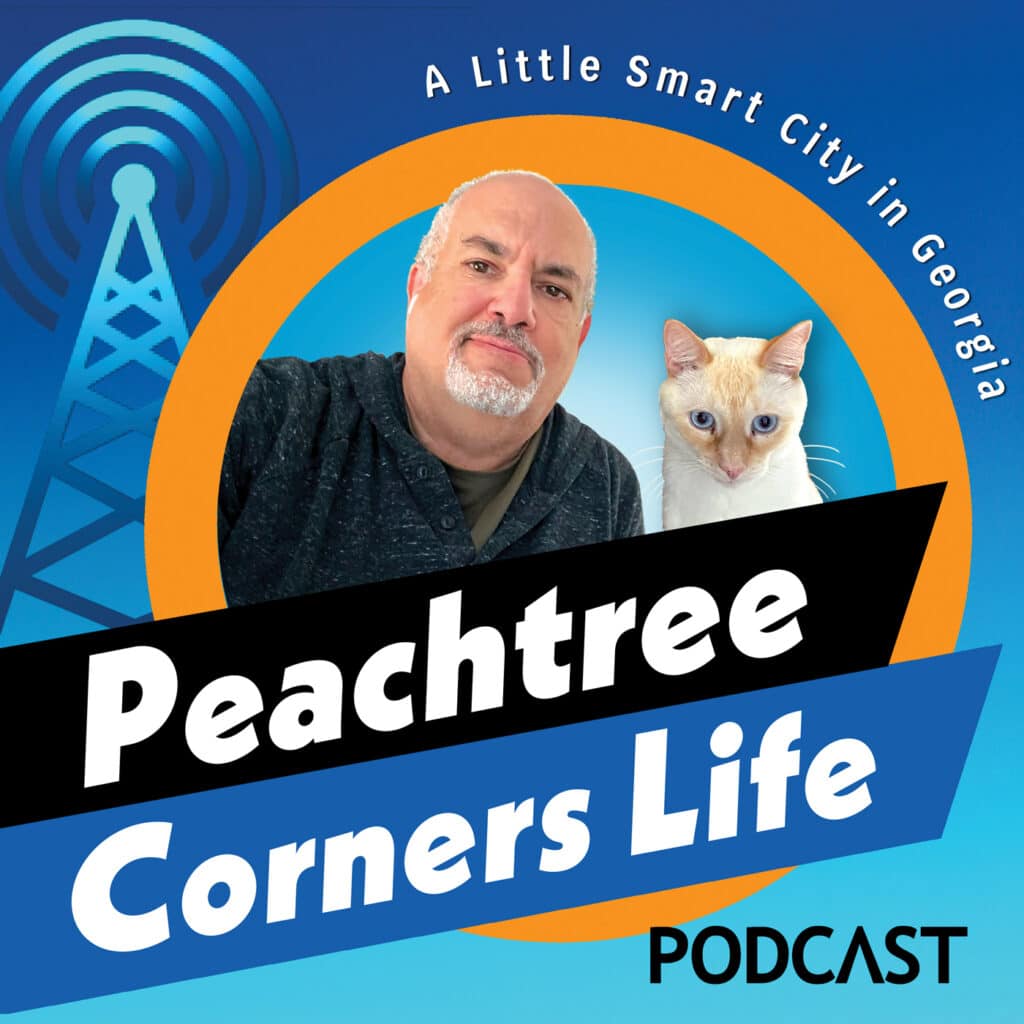
Peachtree Corners Life
Topics and Categories
Trending
-
City Government3 days ago
Peachtree Corners Hosts Discussion About the Future of Local Policing
-
Fitness2 days ago
D1 Training Brings New Fitness Concept to Peachtree Corners
-
Pets & Animals1 day ago
Atlanta’s Dog Howl-O-Ween Festival Moving to Peachtree Corners for 2025
-
Sports38 minutes ago
Local Special Olympics Pickleball Team Honored with State House Resolution





